Growth and Stability in Latin America and the Caribbean: Challenges for the Epoch of Globalization--Lecture by Eduardo Aninat
May 26, 2000
Deputy Managing Director of the International Monetary Fund
Port of Spain, May 26, 2000
I. Introduction
Ladies and Gentlemen:
I am very pleased and honored to deliver the 14th Eric Williams Memorial Lecture. This lecture pays tribute to a distinguished Caribbean statesmen and historian, whose ideals and accomplishments continue to inspire us. In one sense, this honor is difficult for me to fulfill, in that so many illustrious individuals have gone before me, and Dr. Williams managed to bridge the worlds of economics and politics. But in another sense, the task is easy, for many of his words seem more relevant than ever—against a background of increasing globalization of the world economy and a renewed international commitment to combat poverty.
In 1973, in the World Development journal, he wrote that "development has a face and that face is the face of Man. Development must therefore cater for the total needs of that Man." He cited food, clothing, shelter, health, education, freedom, employment, a fair income, and human dignity—a list of needs that should sound familiar to all policymakers. He went on to note that "development is not therefore of a single discipline and does not permit of a unique solution, but consists of a matrix of inter-dependent relationships." This matrix, and the need to decode it, now occupy center stage in international economic debates.
As a representative of the IMF—and a former policymaker myself—I find the idea of a matrix most appealing, for each of us no doubt has a specialization corresponding to a particular cell. Yet the actions we take in that cell have implications for the entire matrix. This underscores the interconnectedness of our globalized world, and it is this interconnectedness that I would like to focus on in my remarks today. But first, let me anticipate the key points that I will be making.
First of all, I will strongly argue that the decade of the 1990s has on average been much better for Latin America and the Caribbean than the "lost decade" of the 1980s and, if we look at it in a broader perspective, probably even better than the decade of the 1970s. This is largely thanks to better economic policies, not spurious improvements in terms of trade, so we have reason to be encouraged. But growth is still too slow and social progress too gradual and too uneven, so there is no room for complacency. Urgent action is needed to strengthen the Region's economic potential and cope with the challenges of globalization—and to do this, countries will have to meet some essential preconditions.
II. Economic and social progress in Latin America and the Caribbean in the 1990s
Let me begin with a brief historical overview to give us a sense of the accomplishments of Latin America and the Caribbean in the 1990s, compared with the previous two decades.
Growth experience
First, growth. In this area, we have an encouraging story to tell. As you can see in Chart 1, the 1990s marked a return of the Region to positive—albeit moderate—annual average per capita growth after stagnation during the 1980s.1 Growth rates peaked at 4 percent in 1997, before dipping during the Asian financial crises and subsequent contagion, and are expected to reach 2.4 percent this year and even higher next year.2 But a word of caution: per capita annual average growth still remains almost two percentage points below the average of the 1970s. Are we unduly encouraged? I think not, for there are other signs that important progress was made during the 1990s.
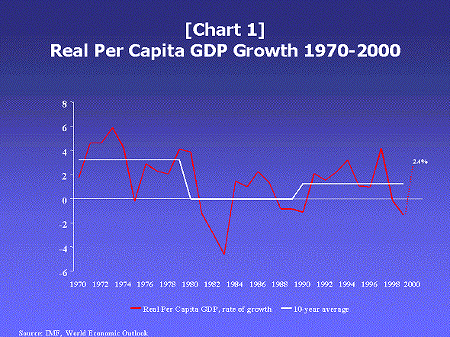
Take the terms-of-trade index. The rebound in growth was not thanks to a simple windfall gain in terms of trade. On the contrary, the average terms-of-trade index was about 12 percent lower in the 1990s than in the 1980s and 25 percent lower than in the 1970s. This means that growth was fueled by a strong expansion in export volumes, among other determinants, at an annual average rate of 8.1 percent in the 1990s, as seen on the right hand side of Chart 2. This is unlike the 1970s, when exports were fueled by favorable terms of trade, export volume growth was rather slow, and most economies in the Region were mostly closed to free trade.
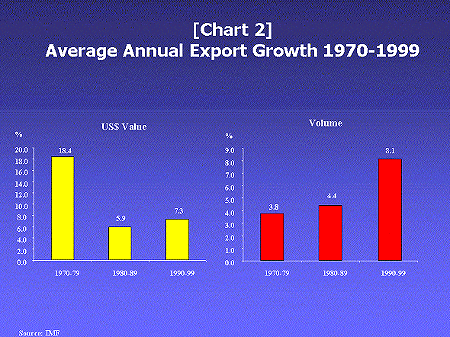
Growth in the 1990s was also sustained by large net private capital inflows into the Region, similar in magnitude to those experienced in the 1970s. This time, however, foreign direct investment—which tends to bring with it the bonus of new technology and knowledge transfers—accounted for slightly more than half of the capital inflows up from about a quarter in the 1970s.
Economic stability: progress to date
Another measure of progress is stability, and here, too, Latin America and the Caribbean turned in a respectable performance:
- Growth rates were more stable. As Chart 3 shows, the standard deviation of real GDP growth fell from 2.5 percent during the 1980s to 1.8 percent in the 1990s, similar to the level in the 1970s. In other words, the majority of the growth rate observations were closer to the average in the 1990s than in the 1970s.
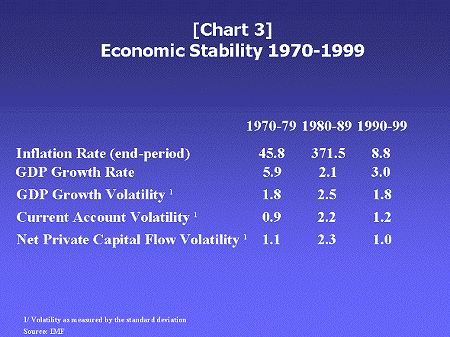
- Prices were much more stable. Average inflation over the past 20 years fell from 45.8 percent in 1979 to 8.8 percent in 1999. This use of a starting and end point is no doubt more meaningful than the period averages, which were distorted and inflated by a few episodes of hyperinflation.
- Current account balances and capital flows were also more stable. The fact that net private capital flows were slightly less volatile in the 1990s than in the 1970s, is actually rather surprising given the two episodes of financial turmoil that hit the Region.
Social progress: positive but slow
How about living conditions? Has better economic performance and stability translated into social progress? In this area, I would tend to say yes. But I would add a note of hesitation because it was not enough to lift the spirits of the general population about the prospects of emerging from poverty.
Let us look at the data, keeping in mind the limitations on both data availability and cross-country comparability. A useful guide is the UNDP's Human Development Index (HDI), which tries to measure average achievements in basic human development—including life expectancy, educational attainment, and income—in one single composite index. A country's HDI value shows the distance that that country has traveled towards the maximum possible value of 1. What is the story for the Region? As Chart 4 shows, since 1975, the gap between the optimal index value of 1 and the actual country index values has been reduced by one-fifth or more in all countries for which information was available.
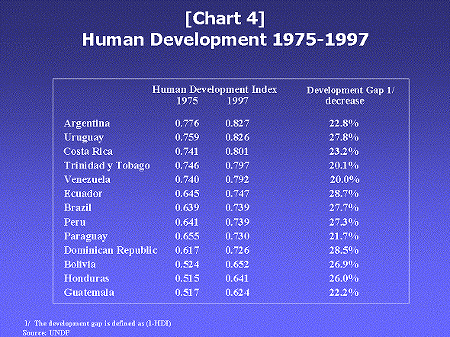
We also see progress on combating poverty. As Chart 5 shows, ECLAC estimates that poverty in the Region rose significantly during the 1980s but has now come back towards the 1980 level. This means that the social cost of the "lost decade" was reversed in the 1990s. Although poverty remains disturbingly high—with almost 185 million people living under the poverty threshold of less than $2 per day—Chile's experience with poverty reduction in the 1990s should encourage us. As Chart 6 shows, poverty can actually be reduced fairly quickly. Chile managed to cut the poverty rate by one half in one decade, thanks to vigorous, sustained growth and well-targeted social policies.
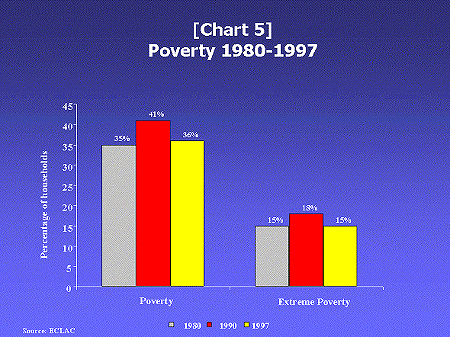
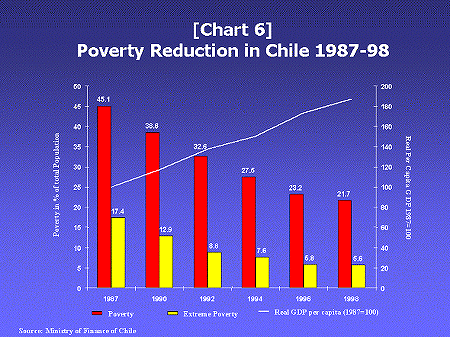
As for relative income distribution patterns, little progress has been made on this front. Even in countries where there has been some improvement, the magnitude of changes has been small. In Honduras, for example, the income captured by the lowest 40 percent of households rose by only 2.1 percent in the 1990s—and this was the highest percentage change for the countries for which data was available. This apparent stickiness in the distribution of income is not too surprising, however, since a rise in household income depends largely on the accumulation of physical and human capital, a process that cannot happen overnight. It takes time!
Country performance: cluster results
So far, we have been looking at regional averages, which as we all know can hide important differences between countries. Of course, a comprehensive discussion of country experiences would be well beyond the scope of this lecture. But we can quickly check the validity of our findings on better growth performance and stability by looking at country performances.
The scatter diagram in Chart 7 depicts the growth performance of 32 countries. The y-axis shows the percentage point increase in the average growth rate that was achieved in the 1990s compared with the 1980s. The x-axis shows the percentage point reduction in GDP growth volatility achieved during the same period.
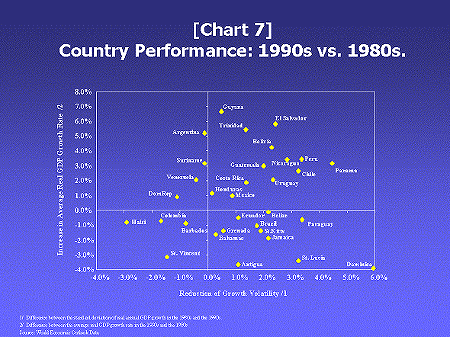
As you can see in the two upper quadrants, 17 countries were able to raise their average annual growth rate in the 1990s. Also, 24 countries—situated in the two right-hand quadrants —were able to reduce the volatility of GDP growth.
The Region's biggest success stories can be found in the upper-right quadrant. These 13 countries achieved both higher growth and greater stability, and you will be pleased to see that Trinidad and Tobago is a featured member in this blessed group. In fact, your country is among the handful of countries that most improved their average annual GDP growth performance in the 1990s. This positive performance certainly reflects the commitment of successive governments to stick to prudent macroeconomic policies.
How did other countries fare? In two of the quadrants we see mixed results. Countries in the lower-right quadrant, such as Brazil, Ecuador, Jamaica and Paraguay, had more stable but lower growth rates. Those in the upper-left quadrant, such as Argentina, Dominican Republic, Suriname, and Venezuela, managed to boost their average growth, albeit at the cost of higher volatility. In the lower-left quadrant, however, we find the negative outliers. These countries—Barbados, Colombia, Haiti, and St. Vincent—had both lower growth rates and higher volatility.
Does this picture change if we compare the performance of the 1990s with that of the 1970s? It is easy to see the difference by comparing Chart 8 with the previous chart. First and foremost, only 9 countries—those located in the two upper quadrants—were able to grow at a higher rate in the 1990s than in the 1970s. Moreover, only six were able to achieve both higher growth and more stability. Trinidad and Tobago managed more stability but growth did fall somewhat on a comparative basis.
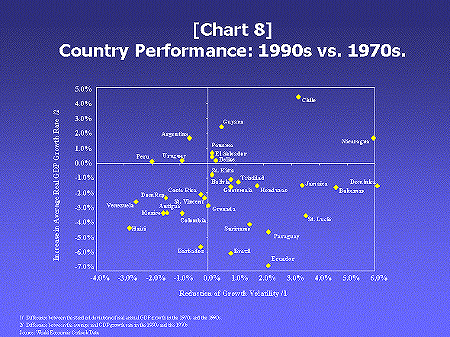
III. Opportunities and risks arising from globalization
To what do we owe the recent better macroeconomic performance of Latin America and the Caribbean? The good news is that the countries themselves can take most of the credit for adopting profound reforms and favorable policies—and then sticking with them for the past 15 years. Much has been written on this subject, so let me only mention some key ones.
- Fiscal deficits in the Region were reduced from 4-5 percent of GDP in the late 1980s to about 2 percent of GDP in the mid-1990s.
- External public debt levels fell from about 50 percent of GDP in the late 1980s to less than 20 percent of GDP.
- Banking regulation and supervision was considerably strengthened and more demanding prudential standards were established.
- Direct credit controls were removed, capital markets were deregulated, and foreign investment regimes were liberalized.
- Nearly 800 public enterprises were privatized between 1988 and 1997, many of them in the utilities sector.
- Most quantitative restrictions were abandoned; average and maximum tariffs fell to 14 percent and 30 percent, respectively, in the late 1990s; and trade agreements in the Region surged.
These and several other measures have helped to boost growth potential and competitiveness. However, the critical question that we must ask ourselves is whether these reforms have been sufficient to put the Region on track for rapid growth and social development.
In my view, there are at least two key reasons why we cannot afford to "lower our guard." First, macroeconomic performance, though much improved, is still not sufficient to tackle the very sizeable social needs in the Region. This means that policymakers now need to not only consolidate past achievements but go further to generate even higher growth rates. In the process, they must strengthen the link between growth and equity if the Region's big inequities are to be reversed.
Second, we are living in a new world—what some observers refer to as a "new economy" —characterized by an accelerating process of integration fueled by a revolution in information technology in communications and in services. For the Region, this promises formidable opportunities. But it also poses a risk of falling back in relative terms if the opportunities to secure a major catch up are not exploited. Let me elaborate on this a little further.
Globalization, of course, is not just a recent phenomenon. Some analysts have argued that the world economy was just as globalized 100 years ago. In fact, by some measures, international economic integration increased probably just as much in the 50 years before World War I as in recent decades. Then, as now, integration was driven largely by the opening of markets and rapid technological change. But what is different about the current episode is the enormous impact that new information technologies are having on market integration, efficiency, and industrial organization—along with its implications for human capital development.
How do these new technologies help? They boost efficiency and growth by reducing information and transaction costs. Lowering these costs tends to lower barriers to entry, increase competition, and contributes to higher investment. Higher market efficiency, and the structural change in the ways businesses operate, represent a positive supply shock that could lead to a quantum shift in overall productivity.
As of now, most of the empirical evidence on this "new economy" comes from the United States, where productivity growth accelerated in the 1980s and picked up further in the mid-1990s, allowing for the maintenance of low inflation even as demand growth was accelerating. Indeed, the numbers are impressive. We are talking about an increase in productivity growth to about 3 percent from 2 percent in the early 1990s and barely 1 percent during the previous 15 years. A recent study by Goldman Sachs estimates that electronic commerce (e-commerce) alone could add 0.25 percent to the annual growth rate of OECD countries over the next ten years. This would be roughly comparable to the increase in potential output brought about by the introduction of the railroads in the United States in the 19th century. Those are the orders of magnitude we are now speaking about!
Of course, information technologies will not replace all of the traditional sectors of the real economies. But they may render traditional production, distribution, and marketing arrangements obsolete, for example, by reducing the economically optimal size of firms or by increasing access to market information. This would create brand new investment opportunities for emerging economies. Let me be more specific. All it takes today to market and distribute a good or a service worldwide—be it Peruvian alpaca sweaters, Brazilian auto parts, or calypso music from Trinidad—is a power connection (to plug in a computer), a phone line (to connect to the internet), a bank account (to handle electronic payments), and a Federal Express bin (to ship the goods). Many parts of the Region could meet these requirements, meaning new opportunities for many producers that previously were shut out of international markets. In the `50s and `60s, isolation was the rule; now it is openness and connectedness.
Another way that new information technologies are changing the face of commerce is by increasing the economic mobility of factors, such as capital, without resorting to physical mobility. The world is gradually moving towards integrated labor markets, particularly in the services sector. Geographic distance has ceased to be a limiting factor for the provision of many services. For Latin America and the Caribbean, this is good news. Already several countries have started to exploit these new opportunities by providing telecommunications and other services to distant lands.
Advances in information processing, financial innovation, and financial liberalization have also unleashed a dramatic expansion in domestic and international financial flows, even after accounting for recent crises. Overall, capital flows have become more important than trade flows in determining the short-term evolution of exchange rates (worldwide, less than 10 percent of foreign exchange transactions are trade-related). Moreover, these capital flows provide a large pool of fresh resources for corporations in emerging markets. The tendency is for a larger role for equity finance, partly reflecting the growing securitization of financial transactions. But, of course, many of these flows have been highly volatile.
So where does this leave us? We know that globalization offers vital opportunities for the Region, be it through making traditional production arrangements more efficient or creating new business opportunities. But there is a downside, indeed, a grave risk. If the region fails to exploit these opportunities, it will be locked into a low productivity growth pattern—perhaps locked into traditional commodities—carrying the risk of falling even further behind the more advanced countries.
In addition, higher international capital mobility tends to increase the vulnerability of national economies—particularly small open economies—to capital account shocks that may stem from inconsistencies in domestic policies or from factors beyond their control (for example, U.S. monetary policy). Integrated capital markets may also impart higher volatility to exchange rates, which particularly hits the tradable sectors, and in emerging economies the nontraditional export sectors.
Moreover, globalization often triggers deep structural change in many sectors and factor markets, since both labor and capital are switched into those sectors that benefit most from the process of market integration. Even if this reallocation of resources is efficient and desirable, it may entail big adjustment costs in the short-run—a point I will come back to later.
IV. Preconditions for success in the global epoch
So the big question is whether Latin America and the Caribbean will be able to exploit the exciting opportunities now unfolding before us and simultaneously safeguard against the risks that the process of globalization entails. My answer is yes, but only if the authorities succeed in firmly putting in place a set of complementary policies that are essential for making globalization work in the peoples' favor. Let me list five of them, among several.
First and foremost, they need to foster good governance and transparency in economic policymaking. A key point that authorities must internalize is that the pressures of globalization are likely to accentuate the benefits of good policies and the costs of bad ones. Countries that demonstrate their commitment to sound macroeconomic and structural policies are likely to earn market confidence, attract trade and capital, and ultimately, put themselves on a path of convergence with the more advanced economies.
How can good governance and transparency be enhanced? Policymakers can do a great deal by providing better and more open and timely information on macroeconomic and financial developments, placing a high priority on prudential financial regulation, and adopting international best practices in areas such as fiscal and monetary transparency, banking disclosure, and accounting.
On the fiscal front, policymakers must essentially modernize the public revenue and expenditure systems. On the income side, globalization may weaken a government's power to tax, as capital in particular moves ever more easily to exploit differences in tax rates across countries, thereby also increasing the potential scope for tax competition. On the expenditure side, outlays need to be better targeted and far more efficient. There also needs to be a clear and decisive reconfiguring of budgets to place a greater weight on cost-effective social outlays that benefit primarily the poor and are consistent with country-owned poverty reduction strategies.
The second of the complementary policies is the need to continually modernize the regulatory framework. Information technologies pose significant regulatory challenges when they generate externalities and increasing returns that traditional economic analysis is poorly equipped to address. While traditional economies of scale lead to relatively stable oligopolies, the information economy works mostly though networks, where monopolies are temporary but offer returns and opportunities to lock customers into a particular technology. The national and international regulatory agencies must have a vigilant and permanently adaptive role here.
In the financial area, issues of network regulation also arise, on top of the challenges from growing financial de-intermediation and the increasingly supranational dimension of financial markets. The worry is that sub-optimal regulation may exacerbate the impacts on business and financial cycles, in a pattern similar to that observed in the early 20th century, another period of rapid financial innovation. With financial flows highly mobile, the pressure is on the need to accelerate the strengthening of regulatory frameworks. Several countries in the Region have taken encouraging steps by adopting and implementing appropriate prudential standards. However, much remains to be done to improve capital adequacy and commercial practices.
Policymakers should pay close attention to any regulatory or fiscal measure that may create distortions in favor of short-term capital inflows and act promptly to remove any such distortion. In addition, in certain specific circumstances, a temporary solution—since building effective supervisory and regulatory institutions takes time—could be price-based prudential controls on capital flows, particularly on short-term flows, as Chile has done until recently. The bottom line is that these new regulatory issues are more of a challenge for emerging economies, given their limited experience in the areas of competition policies and institutional development.
Third, we need to invest heavily in education. It should be abundantly clear by now that all modern-oriented economies are centered on knowledge. Transiting towards the knowledge economy is, therefore, one—if not the most important—challenge facing the Region today. For many decades, the Region's educational policy has been focused on increasing coverage, particularly in primary schooling, with great strides being made. Now policymakers need to make a dramatic switch and focus on improving the quality of education. To date, only a few countries in South America, such as Chile, have decisively embarked on such a switch. But, take heart, the potential payoff is considerable!
In Chile, real outlays on education have increased by 150 percent during the 1990s. Moreover, reforms have included a 30 percent increase in effective classroom time in primary and secondary schools, and the modernization of educational content. Curriculums are being overhauled, and schools are benefiting from new equipment, such as in-class libraries, audio-visual equipment, and computers. In fact, all high schools and half of the primary schools now have computers complete with direct links to the Internet. Chile has also taken many steps to attract new and better public school teachers, including better working conditions, massive retraining, and the creation of scholarships for studies abroad. The hope is that real wages will rise by at least an additional 6 percent in the medium term, directly thanks to productivity gains from these reforms. Moreover, these reforms should help strengthen the link between economic growth and equity, since public schools are usually attended by children from low- and middle-class families.
Fourth, policymakers need to ensure the reliability and cost-efficiency of utilities that are indispensable for participating in the global economy. While many countries in the Region have dramatically improved the supply of critical services—in the areas of power, telecommunications, banking, and transport—mainly through privatization and private concessions, they need to go much further. The experience of Chile, an early follower of this approach, tells us that such steps must be taken with a strong regulatory framework in place. This is necessary to ensure that private sector participation leads to better and more reliable service, and lower costs, benefiting both individual consumers and country competitiveness.
Fifth, policymakers need to cushion the impact of adverse fluctuations in the international economic environment by erecting contingency mechanisms. Stabilization funds—that are well designed and transparent—would smooth price fluctuations for large commodity exporters, a route that Chile and Mexico, for example, have taken. These must, of course, always be supported by a sound fiscal policy. Chile has successfully used a copper stabilization fund for almost a decade, which was created with World Bank technical assistance—and Trinidad and Tobago has recently designed and implemented a similar mechanism to stabilize the economy from oil price fluctuations. Effective and well-targeted social safety nets can provide safeguards against excessive social costs that may transitorily arise from structural change or from the impact of volatile capital flows. They would also help spread the net benefits of globalization, thereby strengthening the positive links between economic growth and social equity. Of course, the time to build up these nets would be during the good times.
V. IMF and latin america and the caribbean
So how does the IMF fit into this picture? The IMF, together with other multilateral financial institutions, stands ready to support the countries in their reform efforts, be it through financial assistance, technical assistance, or policy advice. Our collaboration with Latin American countries is indeed significant: the IMF now has programs in place with 13 countries in the Region, for a total of about $30 billion. Our technical assistance—ranging from macroeconomic management and statistics to tax policy and administration, social security reform, financial law, and information technology—involves the equivalent of over 8,000 days of staff time each year. In the context of the "Caribbean Initiative," discussions are currently under way on establishing a Caribbean Regional Technical Assistance Center, in collaboration with other regional and multilateral institutions and bilateral donors.
You know we are making great efforts to strengthen the Fund's surveillance. In this regard, several Latin American and Caribbean member countries have volunteered for the various pilot programs on release of Article IV Staff Reports, experimental reports on the implementation of standards and codes, and the Financial Sector Assessment Program. You have also been in the forefront of improving banking systems, enhancing relations with creditors, and increasing transparency—including through better data dissemination.
Of course, the IMF is also working hard to make the global financial system more conducive for all countries to flourish. This includes streamlining our loan facilities, intensifying efforts to help reduce poverty, and searching for more ways to help prevent and resolve crises. For as the global economy evolves, so does the IMF, as it has ever since its inception. In all of these endeavors, the membership as a whole has much to learn from the experience of Latin America and the Caribbean. We look forward to your views and inputs. Indeed, your contributions are crucial.
In recent months, at least five reports have been issued on ways to reform the international financial institutions, several of them highly critical of the way the IMF does business. No doubt the most critical was the majority report issued by a U.S. congressional-appointed commission, known as the Meltzer Commission. But I fear that an essential message is being lost in this report, as pointed out by Fred Bergsten, who sat on the commission and signed the dissenting minority report. Here I quote from a recent journal article by him:3 "First, the Meltzer report paints a very misleading picture of the impact of the international financial institutions over the past fifty years. The economic record of that period is a success unparalleled in human history, both for the advanced industrial countries and for most developing nations. Hundreds of millions of the poorest people on earth have been lifted out of poverty. The severe monetary crises of recent years have been overcome quickly with little lasting impact on the world economy. The international financial institutions have contributed substantially to this record."
So let us go forward with a keen sense of history in mind. The IMF now has its marching orders from the International Monetary and Financial Committee—its policymaking body—to reshape the IMF to reflect our increasingly globalized world. This we will do, ever mindful of the needs of all of our member nations.
VI. final thoughts: globalization and human development
I began this lecture with a quotation from Dr. Eric Williams, in which he explicitly calls for development having a human face. I would like now, in closing, to comment on what seems to be a key challenge in understanding more fully the immense opportunities, as well as the risks, that globalization offers us all—for it involves a long-term perspective, with a human face. To date, globalization debates have centered on capital flows and financial markets. But I would like to suggest that we should be looking elsewhere for guidance.
When I was a student at Harvard University 30 years ago, a famous group of professors held heavily attended seminars on the question: "What do bosses do?" This was a sort of radical exchange to "better understand" the roots of capitalism. I would like to suggest that now, in May 2000, at the dawn of the new millennium, globalization is raising a very different and much more broad-ranging question: "What will workers do?"
Globalization is changing the way we interact and the way we position ourselves. It is silently but inexorably changing the way we consume, save, and work! Thus, what is needed is a fresh and open rethinking of the post-modern labor markets. We need to understand—more fully and deeply—the changes in the labor place and the labor markets, along with the changes for workers (both skilled and unskilled). I am firmly convinced that the true, more profound nature of the globalization process lies in this area.
Of course, I am foreseeing here a profound revolution in the ways we produce, live, learn, and contract for labor services of all kinds. How should we respond to this futuristic, paradigmatic change? No doubt a dramatically important one! I do not have the answer. But I do know that—following the inspired vision of Dr. Eric Williams—when we are able to come to terms with these new labor characteristics, we shall encounter perhaps the human face of the development process. It is for us, key actors in the present, to shape whether it shall be a smiling face or a face of sorrow and despair!
REFERENCES
CEPAL
"Panorama Social de América Latina"
Santiago, 1999
CEPAL
"América Latina y las crisis
Santiago, 1999
UNDP
"Human Development Report 1999"
New York, 2000
IMF
World Economic Outlook
Washington, various issues
Ministry of Finance of Chile
State of the Economy Address
Santiago (Chile), various issues
1Sum or PPP-weighted average of 32 countries (Antigua & Barbuda, Argentina, the Bahamas, Barbados, Belize, Bolivia, Brazil, Chile, Colombia, Costa Rica, Dominica, the Dominican Republic, Ecuador, El Salvador, Grenada, Guatemala, Guyana, Haiti, Honduras, Jamaica, Mexico, Nicaragua, Panama, Paraguay, Peru, St. Kitts & Nevis, St. Lucia, St. Vincent & the Grenadines, Suriname, Trinidad & Tobago, Uruguay and Venezuela).
2This is consistent with GDP average growth of 4 percent for the Region as a whole.
3 The International Economy, May June 2000.
IMF EXTERNAL RELATIONS DEPARTMENT
| Public Affairs | Media Relations | |||
|---|---|---|---|---|
| E-mail: | publicaffairs@imf.org | E-mail: | media@imf.org | |
| Fax: | 202-623-6278 | Phone: | 202-623-7100 | |


